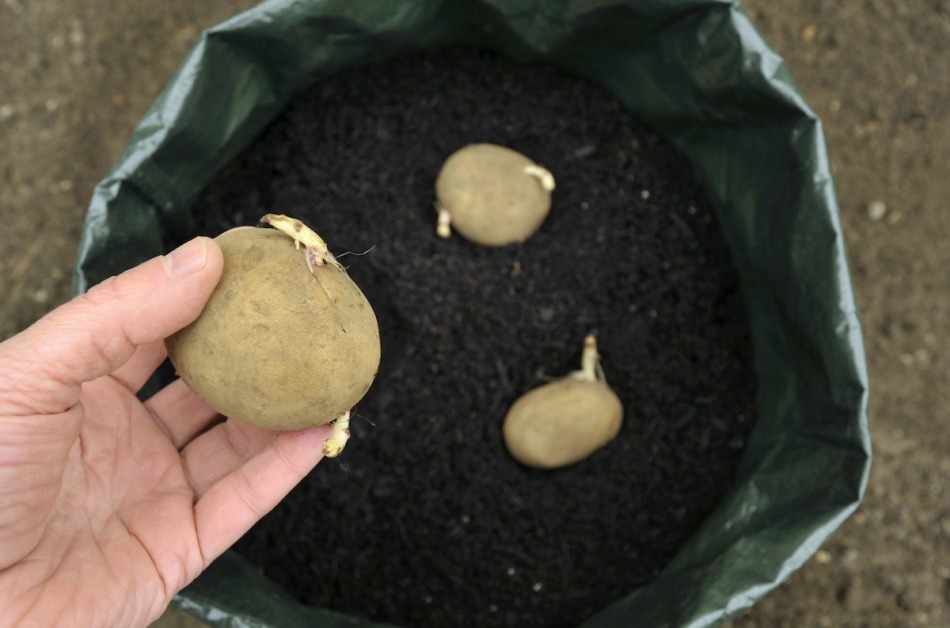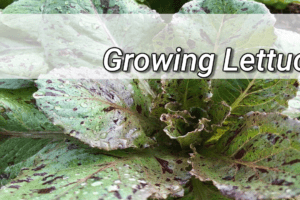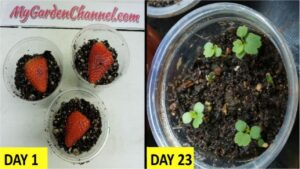Seven vegetables you can grow in February has to start with lettuce.
If you are in the Southwest you can start them outside such as spinach, peas, greens, onions, potatoes, lettuce, Swiss chard, beets, carrots, and radishes.
For the rest of us we have to start them indoors.
Growing Lettuce in February
Lettuce seeds can germinate in temperatures less than 50 degrees F. Which makes this a great vegetable for February. It doesn’t mind the colder weather.
Lettuce is a cool-weather crop that thrives in the temperature range 60-65 degrees F, and if thoroughly hardened, most varieties survive temperatures as low as 20 degrees F.
Cold-adapted varieties survive much lower temperatures. Seed germination needs to be 50 F or above and then the seedlings can be slowly hardened off to adapt to the cooler temperatures outdoors.
How To Grow Potatoes in February

Growing potatoes in February is possible, but it depends on your climate and the specific variety of potato you are trying to grow. Here are some general tips for growing potatoes:
- Choose a sunny location with well-draining soil for your potato plants.
- Start by planting potato seeds or “seed potatoes” in pots or containers indoors, or directly in the ground if the weather is warm enough.
- Water the plants regularly, making sure to keep the soil evenly moist but not waterlogged.
- As the plants grow, you can add a layer of soil, compost, or mulch around the base of the plants to help them grow more potatoes. This process is called “hilling.”
- When the plants are about 6 inches tall, they should be ready to be transplanted outdoors if the weather is warm enough. If it is still cold in February, you may need to wait until later in the spring to transplant the plants.
- Protect the plants from frost and extreme weather conditions. You can cover them with blankets or plastic sheeting if necessary.
By following these steps, you can successfully grow potatoes in February, or any other time of year. Just be sure to choose a variety of potato that is suitable for your climate and growing conditions.
Grow Beets in Winter

Growing beets in February is possible, but it depends on your climate and the specific variety of beet you are trying to grow. Here are some general tips for growing beets:
- Choose a sunny location with well-draining soil for your beet plants. Beets prefer soil that is rich in organic matter and has a pH between 6.0 and 7.0.
- Start by planting beet seeds directly in the ground or in pots or containers indoors.
- Water the plants regularly, making sure to keep the soil evenly moist but not waterlogged.
- Fertilize the plants every few weeks using a balanced fertilizer to encourage healthy growth.
- As the plants grow, thin them out so that there is enough space between them for proper growth.
- Protect the plants from frost and extreme weather conditions. You can cover them with blankets or plastic sheeting if necessary.
By following these steps, you can successfully grow beets in February, or any other time of year. Just be sure to choose a variety of beet that is suitable for your climate and growing conditions.
Winter Carrots

Growing winter carrots in February is possible, but it depends on your climate and the specific variety of carrot you are trying to grow. Here are some general tips for growing winter carrots:
- Choose a sunny location with well-draining soil for your carrot plants. Carrots prefer soil that is rich in organic matter and has a pH between 6.0 and 6.8.
- Start by planting carrot seeds directly in the ground or in pots or containers indoors.
- Water the plants regularly, making sure to keep the soil evenly moist but not waterlogged.
- Fertilize the plants every few weeks using a balanced fertilizer to encourage healthy growth.
- As the plants grow, thin them out so that there is enough space between them for proper growth.
- Protect the plants from frost and extreme weather conditions. You can cover them with blankets or plastic sheeting if necessary.
By following these steps, you can successfully grow winter carrots in February, or any other time of year. Just be sure to choose a variety of carrot that is suitable for your climate and growing conditions.
Growing Onions in February
Growing onions in February is possible, but it depends on your climate and the specific variety of onion you are trying to grow. Here are some general tips for growing onions:
- Choose a sunny location with well-draining soil for your onion plants. Onions prefer soil that is rich in organic matter and has a pH between 6.0 and 7.0.
- Start by planting onion seeds or “sets” (small onion bulbs) directly in the ground or in pots or containers indoors.
- Water the plants regularly, making sure to keep the soil evenly moist but not waterlogged.
- Fertilize the plants every few weeks using a balanced fertilizer to encourage healthy growth.
- As the plants grow, thin them out so that there is enough space between them for proper growth.
- Protect the plants from frost and extreme weather conditions. You can cover them with blankets or plastic sheeting if necessary.
By following these steps, you can successfully grow onions in February, or any other time of year. Just be sure to choose a variety of onion that is suitable for your climate and growing conditions.
How to Grow Peas Vegetables in Winter
Growing peas in February is possible, but it depends on your climate and the specific variety of pea you are trying to grow. Here are some general tips for growing peas:
- Choose a sunny location with well-draining soil for your pea plants. Peas prefer soil that is rich in organic matter and has a pH between 6.0 and 7.0.
- Start by planting pea seeds directly in the ground or in pots or containers indoors.
- Water the plants regularly, making sure to keep the soil evenly moist but not waterlogged.
- Fertilize the plants every few weeks using a balanced fertilizer to encourage healthy growth.
- As the plants grow, provide them with a trellis or other support structure to climb on.
- Protect the plants from frost and extreme weather conditions. You can cover them with blankets or plastic sheeting if necessary.
By following these steps, you can successfully grow peas in February, or any other time of year. Just be sure to choose a variety of pea that is suitable for your climate and growing conditions.
Start Growing Spinach in February Vegetable Garden
Growing spinach in February is possible, but it depends on your climate and the specific variety of spinach you are trying to grow. Here are some general tips for growing spinach:
- Choose a sunny location with well-draining soil for your spinach plants. Spinach prefers soil that is rich in organic matter and has a pH between 6.0 and 7.0.
- Start by planting spinach seeds directly in the ground or in pots or containers indoors.
- Water the plants regularly, making sure to keep the soil evenly moist but not waterlogged.
- Fertilize the plants every few weeks using a balanced fertilizer to encourage healthy growth.
- As the plants grow, thin them out so that there is enough space between them for proper growth.
- Protect the plants from frost and extreme weather conditions. You can cover them with blankets or plastic sheeting if necessary.
By following these steps, you can successfully grow spinach in February, or any other time of year. Just be sure to choose a variety of spinach that is suitable for your climate and growing conditions.
There are 7 Vegetables You Can Grow in February including: Lettuce, Beets, Carrots, Potatoes, Onions, Peas and Spinach.


